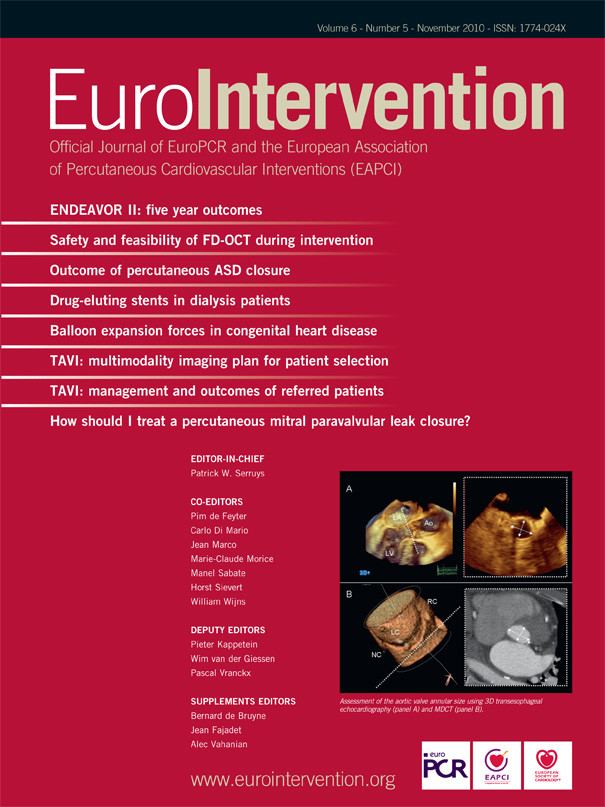Dear colleagues,
The month of October saw the beginning of an impressive new endeavour in medical education. In the early part of the month, one of the first dedicated European meeting on valves was held in London, ushering in what we believe to be the start of a new era for transcatheter valve implantation as it is seen increasingly as state-of-the-art clinical practice, and not as an only experimental option and procedure.
When Jean Marco, Martyn Thomas and I began this meeting, we were pleasantly surprised to find ourselves addressing a full auditorium with all 850 seats occupied. The ambiance, in those first few first minutes, reminded me of the electric atmosphere of the early days of Andreas Gruentzig’s demonstrations, and this level of excitement stayed with us throughout the course.
The first panel discussion was composed of pioneers in this field, and from that very moment we experienced a level of communication, a desire to learn, and a commitment to discuss the various issues that confront TAVI at the very highest level. Every live demonstration was of excellent pedagogic value, with a quality of articulation, an accent, if you will, that embodied the “best of British” – and all this in a very relaxing atmosphere, as well. Throughout, there was a mutual respect for both participants and speakers, which could be seen in the personal discipline of the different presentations, all keeping to the prescribed schedule, within time limits ranging from 20 to 45 minutes each. The live demonstrations were impressive as well, with our British colleagues impressing us with their self-composure while performing complex procedures such as aortic valve implantation, or mitral valve repair.
Clearly one of the major impacts of this type of course is also to underline both the necessity – as well as the current reality – of the symbiosis between the surgeon, the interventional cardiologist, the anaesthetists, the echographists and all the other multidisciplinary experts involved in this procedure.
In short, the variety of treatments demonstrated in the less than two days of PCR London Valves was truly spectacular, all seamlessly made possible by the impeccable organisation and experience of the PCR team, with it’s long experience and deep understanding of our field.
TAVI, in our journal
It is only fitting that this current issue of EuroIntervention should have two important papers addressing issues involved in percutaneous valve implantation. The first, concerning the “Impact of treatment choice on the outcome of patients proposed for transcatheter aortic valve implantation” by Marco De Carlo et al, offers us a “real-world” decision making flow chart between medical management, balloon aortic valvuloplasty, surgical aortic valve replacement and percutaneous aortic valve replacement. While I would not like to specifically comment on certain of the figures (Figures 2, 3 and 4, due the non-randomised approach employed here), I must say that the results are nevertheless puzzling and, for me, extremely intriguing.
It is clear that there are many aspects of our current practice in relation to TAVI that need to be addressed. I had the privilege to give the last lectures at the London course, and in my conclusion I urged our partners – surgeons and interventional cardiologists alike – to concentrate and re-engage themselves in the practice of a true evidence-based medicine. We must continue our commitment to randomised trials and registries, thereby discovering and insuring the best as well as the most appropriate therapy options for our patients. As was shown in the PARTNER Registry, medical management results in a mortality of 50% within one year, something we need to take into account and answer to the best of our ability.
The second paper on TAVI in this current issue of EuroIntervention is on “Multimodality imaging in transcatheter aortic valve implantation: key steps to assess procedural feasibility” by Victoria Delgado and colleagues. This paper emphasises – beyond the multidisciplinary approach necessary to master the TAVI technique itself – the need to use multi-modality imaging; crucial, not only in the intervention itself, but before, in the selection of the appropriate candidate; as well as in the evaluation of that candidate’s feasibility for a specific intervention.
We are at the cusp of exciting developments. TAVI is leaving behind its “pioneer” stage and entering into a vibrant maturity. In the next few weeks the publication of the VARC paper, outlining standardised endpoints definitions for TAVI trials, will change much in the way we see – and accept – this treatment option, but as always, it is through you, specialists and researchers in the field, that the true worth of these ground breaking treatments will be achieved. It is in your participation in meetings like this recent one in London, and your reaction to these developments, that we advance. We are a community, and after London, I can happily say, we are a vibrant and challenging one.

